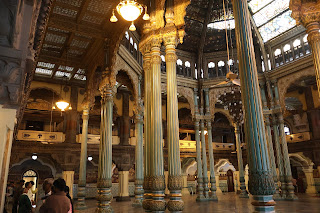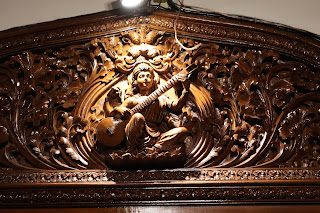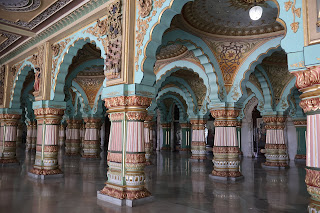Mysore Palace, also known as Amba Vilas Palace, is a historical palace and a
royal residence. It is located in Mysore, Karnataka, India.
It used to be the official residence of the Wadiyar dynasty and the seat of
the Kingdom of Mysore.
The palace is in the centre of Mysore, and faces the Chamundi Hills eastward.
|
Entering through the south gate (Balarama)
Balarama is a
major deity and is known as the elder brother of Krishna.
-
The name "Balarama" comes from two Sanskrit words: "Bala," which means
"strength" or "power," and "Rama," which can mean "pleasure" or is a
name often associated with another major deity, Lord Rama. So,
Balarama can be interpreted as "the strong one" or "the one who gives
joy through strength."
-
Balarama is often depicted carrying a plow (symbolizing agriculture
and productivity) and a mace (symbolizing strength and power). He is
considered an embodiment of physical strength, loyalty, and duty. His
stories are closely intertwined with those of Krishna, and he plays a
pivotal role in many of the events described in Hindu scriptures,
particularly the Mahabharata and Bhagavata Purana.
|
|
Shri Shvethavaraha Swami Gudi
Shri Shvethavaraha Swami Gudi,
also known as the Varahaswamy Temple, is a revered Hindu temple located
next to the south gate of the palace.
-
It is dedicated to Lord Varaha, the third avatar of Vishnu, who is
depicted as a boar.
-
The temple is known for its unique dedication to this incarnation,
believed to have rescued the Earth from the demon Hiranyaksha.
-
The temple's architecture is a splendid blend of Dravidian and Hoysala
styles, featuring intricately carved pillars, ornate ceilings, and
detailed sculptures depicting various mythological scenes.
-
The sanctum sanctorum houses a magnificent idol of Lord Varaha,
symbolizing the divine act of saving the Earth.
-
Shri Shvethavaraha Swami Gudi is not only a place of worship but also
a site of historical and cultural importance.
-
It attracts devotees and tourists alike, especially during festivals
like Varaha Jayanti.
|
|
Panorama of the south side of the palace
|
|
Panorama of the courtyard
|
|
Main building of the palace seen from the courtyard
|
|
Bronze lion statues in the courtyard
|
|
The wedding hall
-
The Kalyana Mandapa wedding hall is a large octagonal pavilion with a
multi-coloured stained glass ceiling, with geometrically arranged
peacock motifs. The entire structure was made in Glasgow, Scotland.
-
The floor also features a peacock mosaic, designed with tiles from
England. Oil paintings depicting the royal procession and Navratri
celebrations of yesteryear are displayed on the walls.
|
|
Color tinted glasses on the ceiling
The Mysore Palace had a
number of Durbar halls, especially the Peacock Hall, having color tinted
glasses imported from Belgium, which were used for marriage ceremonies.
|
|
Chamundeswari Rathothsava
Chamundeswari Rathothsava is a
grand and vibrant festival celebrated at the Chamundeshwari Temple atop
Chamundi Hill in Mysore, Karnataka.
-
The term "Rathothsava" translates to "chariot festival" in Sanskrit.
During this festival, a beautifully decorated chariot carrying the
idol of Goddess Chamundeshwari is pulled by devotees through the
temple streets.
-
The festival is part of the Mysuru Dasara celebrations, a 10-day event
that culminates with the Rathothsava. It's a time of great joy and
devotion, attracting thousands of devotees and visitors who come to
witness the procession and seek the blessings of the Goddess.
|
|
Panorama of the silver chairs hall
|
|
Wood carving of Saraswati in the silver chairs hall
Saraswati is a revered goddess in Hinduism, often associated with
knowledge, music, art, wisdom, and learning.
-
Saraswati is the goddess of learning and intellect. She represents the
free flow of wisdom and consciousness. Her presence is invoked in
pursuits of education and scholarly endeavors.
-
Often depicted holding a veena (a musical instrument), Saraswati is
also the patroness of music, arts, and creativity. She inspires
artistic and musical talents.
-
She is usually depicted in white attire, symbolizing purity, clarity
of thought, and a clean, unbiased mind.
-
Saraswati is associated with speech (Vak) and eloquence. She is
believed to bestow the gift of eloquent and harmonious speech upon her
devotees.
-
Her serene and composed demeanor signifies calmness and a balanced
mind, important attributes for intellectual and creative pursuits.
-
She holds a book, representing the Vedas, which signifies knowledge
that dispels ignorance and leads to enlightenment.
|
|
Wooden carving of Ganesha in the silver chairs hall
Ganesha
is easily recognizable by his distinctive elephant head and human body.
-
Ganesha is renowned for his role as the remover of obstacles, making
him a deity invoked at the beginning of new ventures, journeys, and
important undertakings.
-
Ganesha is a deity of intellect and wisdom, often worshipped by
students, artists, and scholars seeking success and creativity in
their endeavors.
-
He is worshipped at the start of rituals and ceremonies. His blessings
are sought to ensure the smooth execution of events and projects.
-
Ganesha is depicted holding a book or manuscript, representing
knowledge and learning. His large head symbolizes the wisdom he
bestows upon his devotees.
|
|
Dolls' pavilion
The palace is entered through a gallery
displaying traditional dolls from the 19th and early 20th centuries.
-
The pavilion also houses a fine collection of Indian and European
sculptures and ceremonial objects, including a wooden elephant
palanquin decorated with 84 kg (185 lbs) of gold.
|
|
Entering the public audience hall
|
|
Plaster of Paris statue of Krishnaraja Wadiyar IV who was
instrumental in the construction of this palace
Krishnaraja Wadiyar IV, also known as Nalwadi Krishnaraja
Wadiyar, was the 24th Maharaja of Mysore, reigning from 1902 until his
death in 1940. He is often referred to as the "father of modern Mysore"
due to his significant contributions to the state's development and
modernization.
-
He established numerous educational institutions, including the
University of Mysore, and promoted higher education.
-
Under his rule, Mysore saw extensive infrastructure development,
including the construction of wide roads, bridges, and public
buildings.
-
He founded several hospitals and health institutions, such as the
Minto Ophthalmic Hospital (one of the oldest eye hospitals in the
world).
-
He promoted industrialization and economic growth, making Mysore one
of the most prosperous states in India at the time.
-
Krishnaraja Wadiyar IV was a patron of arts and culture, supporting
various cultural and artistic endeavors.
-
He was known for his philosophical and saintly approach to kingship,
earning him the title "Rajarshi" (saintly king) from Mahatma Gandhi.
His reign is often considered the golden age of Mysore due to the
significant progress and prosperity achieved during his time.
|
|
Public audience hall
Diwan-e-aam, a public durbar where the
people could meet the king at appointed times, to present petitions.
|
|
Panorama of the public audience hall seen from east to west
|
|
Panorama of the public audience hall seen from west to east
|
|
Entering the private audience hall
Access to this opulent
room is through an elegant rosewood door inlaid with ivory which opens
onto a shrine dedicated to Ganesh.
|
|
Panorama of the private audience hall
-
The central nave of the hall is decorated with gilded columns, stained
glass windows, decorative steel grilles and floral chandeliers, the
mosaic floor is decorated with semi-precious stones.
-
This is where the king conferred with his ministers and received
people who deserved special attention.
|
|
Another panorama of the private audience hall
|
|
Central space of the private audience hall
|
|
Access door to the private audience hall
|
See Also
Source
Location
Chennakeshava Temple, Somanathapura
Chamundeshwari Temple, Mysuru
Mahabaleshwara Temple, Mysuru
Devaraja Market, Mysuru




























































